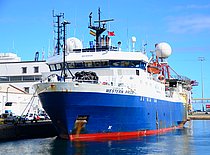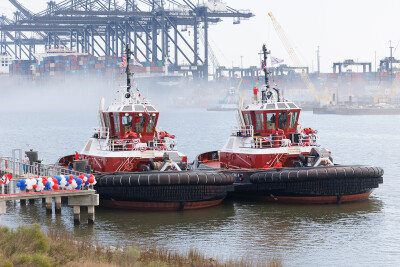The National Oceanic and Atmospheric Administration announced it is opening a 30-day public comment period as it prepares to act on five permit requests from geophysical companies to conduct seismic surveys for potential oil and gas off the Mid-Atlantic and Southeast coast.
In a notice issued Monday, the agency said its move is a step toward implementing President Trump’s executive order seeking to reopen offshore development on the outer continental shelf, from Delaware south to Georgia
The clock starts running with publishing the notice in Tuesday’s Federal Register. Reviving the process brings back permits that were sought last year from the Obama administration by three Houston-based geophysical companies — WesternGeco LLC, ION GeoVentures, and Spectrum Geo Inc. — plus CGG, Paris, France, and TGS-NOPEC Geophysical Company, Asker, Norway.
The WesternGeco application submitted in 2015 to NOAA described a work plan for 208 days, with the 234.5'x55'x7'x21' survey ship Western Pride working from a point off the coast of Maryland down to 50 miles east of St. Augustine, Fla., some 17,000 linear miles of surveying at 4 to 5 knots over depths ranging from 65’ to 15,400’.
“Continuing this process is consistent with the goals of Presidential Executive Order 13795, Implementing an America-First Offshore Energy Strategy, which encourages energy exploration and production that fosters energy security and resilience for Americans, while ensuring those activities are safe and environmentally responsible.
“NOAA Fisheries will use the best available information in considering the requirements of the Marine Mammal Protection Act relating to incidental take during proposed geophysical surveys in this region.”
“We have no reason certainly to anticipate mortality from this” among whales and other marine mammals, said Jolie Harrison, chief of the permits and conservation division in NOAA Fisheries Office of Protected Resources, in a conference call with reporters.
The agency is focused on the likelihood of sea life being disrupted in feeding, movement and other behaviors by the noise from air guns used to generate the low-frequency sound, said Harrison. While there is “small potential” for hearing impairment at closer range, the bigger impact are what NOAA defines as “level B” harassment under the Marine Mammal Act, meaning temporary alterations in animal behavior.
Environmental groups have long fought against seismic permits as a key strategy to block oil and gas development in the Atlantic, working with a coalition of tourism and fishing industry groups and coast communities. They achieved a seeming victory when the outgoing Obama administration blocked the seismic permits and withdrew the Atlantic from offshore planning, and are now scrambling to fight the Trump administration’s reversal.
NOAA “is applying a 20 year old standard it admits is outdated,” said Michael Jasny, director of marine mammal protection with the Natural Resources Defense Council, a major organizer of the campaign against East Coast drilling.
Commercial fishermen in the region already struggling with regulations and catch limits cannot see the urgency for Atlantic exploration when there are “proven (oil and gas) reserves on land that will sustain this nation for decades to come,” said Rick Baumann, who owns Murrells Inlet Seafood in South Carolina, in a conference call NRDC held with reporters.
While the offshore industry has applauded Trump’s moves, there is also plenty of skepticism about the economic chances of developing on the Atlantic outer continental shelf. Beyond today’s environment of $50 bbl. prices, a handful of earlier surveys from the 1970s to early 1990s found few prospects.
“I think it was less than 1% of proven reserves,” said Douglas Nowacek, a professor at Duke University who studies sound in the ocean. Nowachek was among 75 scientists who signed on to a 2015 letter opposing seismic surveys, and he said the prospect is a serious danger to the critically endangered north Atlantic right whale.
With fewer than 500 individuals left, the right whales range from New England south to calving grounds off the Southeast coast, and the sound of 24/7 air guns could disrupt their movement, feeding and communication with young calves, Nowacek said.
NOAA is outlining a list of mitigation measures to reduce marine mammal interactions, including observers on surveys and use of passive acoustic detection to listen for whales.
As a fisherman Baumann said he is skeptical. “When you’re offshore and it’s blowing northeast with 4’ to 6’ swells you can’t see more than a few hundred yards,” he said, dismissing the observer requirements as “just a smokescreen.”
After NOAA grants authorization for the incidental takes, the Bureau of Ocean Energy Management would authorize geological and geophysical (G&G) permits good for one year. Conceivably, “as early as this fall you could start seeing seismic off the East Coast,” said Jasny of NRDC.
Photo courtesy ShipSpotting.com
| ShipSpotting.com |
 |
| © Patalavaca |





[5] copy.png.small.400x400.png)